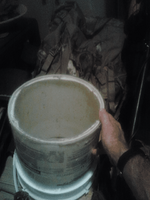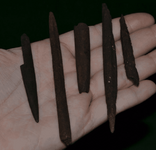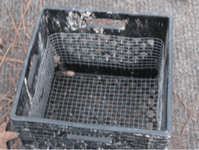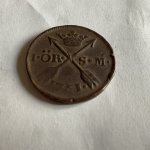monsterrack
Silver Member
- Apr 15, 2013
- 4,419
- 5,815
- Detector(s) used
- Garrett, and Whites
- Primary Interest:
- All Treasure Hunting
I am no expert but these are things that have worked for me over the years. First I would say and it should go unsaid but take your time and walk slow. As I said in another post I do what I call the duck walk ,I bend over and place my hands on my knees and get a real close look, and I know some folks have back problems and can't do that, so never try to look over a square area of 3ft then take a step and start over. After I go down the rock bar in one direction I turn around and go back the way I came, until I have walked the whole bar like that, believe me a different angle gives a complete different view. Then before I leave that rock bar I stand up straight look high up on the banks, I have found points more than 5ft out of the creek beds and you never know what may be sticking out of the bank and also as I am walking on to the next rock bar I'm still looking at the ground that I just looked over. Also look in the water, if it is shallow enough make sure the sun is at your back so there will not be a glare. If the water is deep 1-3ft, you can cut the bottom out of a plastic bucket and put plexa glass in the bottom using rubber silicone to seal it in , be sure to leave about a 1/2 of a inch of the bottom of the bucket around the edge, so the plexa glass will have a good area to seal too, the bucket thing helps when there is a lot of ripples no matter the depth of the water, by placing it in the water it is amazing what you can see. Just be sure to walk up stream, so not to cloud up the water and that is another pointer when walking creeks always try to start down stream and work your way up stream.
I know some will say this will take all day and it does take a long time to search a place just right, because you never know what you may walk right by. I have found this works in fields also, you just don't have to walk has slow in a plowed field. I have walked right past a tip of a point in a field only to find it when I came back just a few feet away looking at a different angle. In my line of work and most any kind you need to double check things, so it goes in hunting artifacts. I hope this will help someone and like I said this is just the way I do it , others may have some better tips and I would like to hear some of them myself, because this old dog can learn new tricks.
I know some will say this will take all day and it does take a long time to search a place just right, because you never know what you may walk right by. I have found this works in fields also, you just don't have to walk has slow in a plowed field. I have walked right past a tip of a point in a field only to find it when I came back just a few feet away looking at a different angle. In my line of work and most any kind you need to double check things, so it goes in hunting artifacts. I hope this will help someone and like I said this is just the way I do it , others may have some better tips and I would like to hear some of them myself, because this old dog can learn new tricks.
Upvote
0









